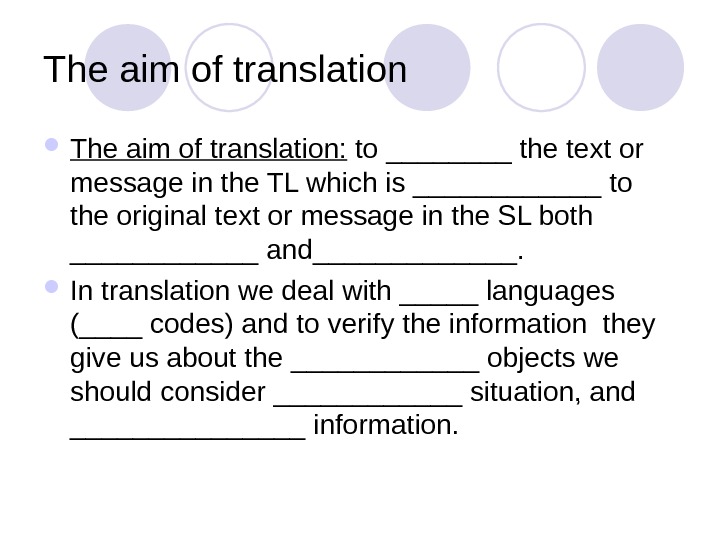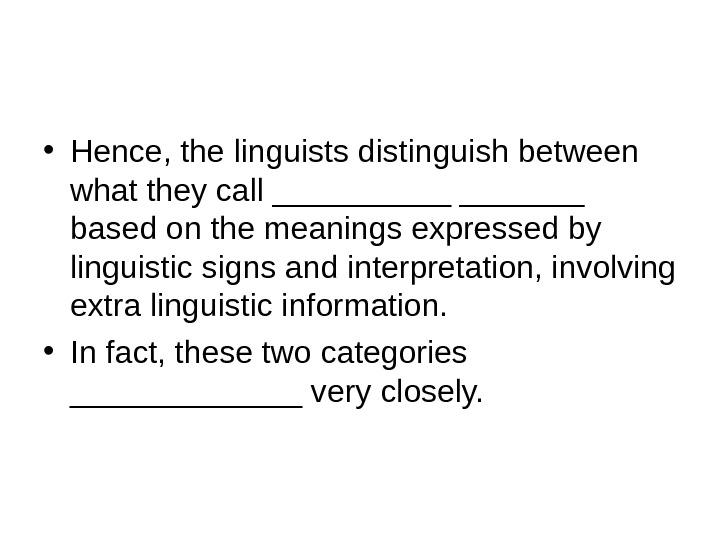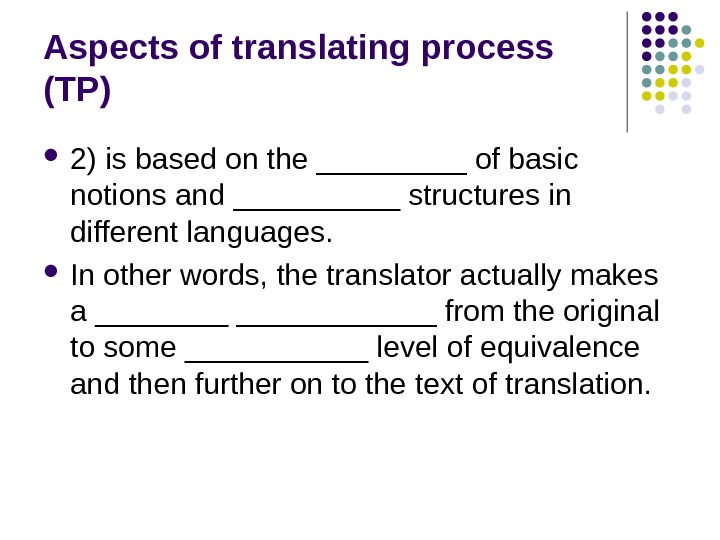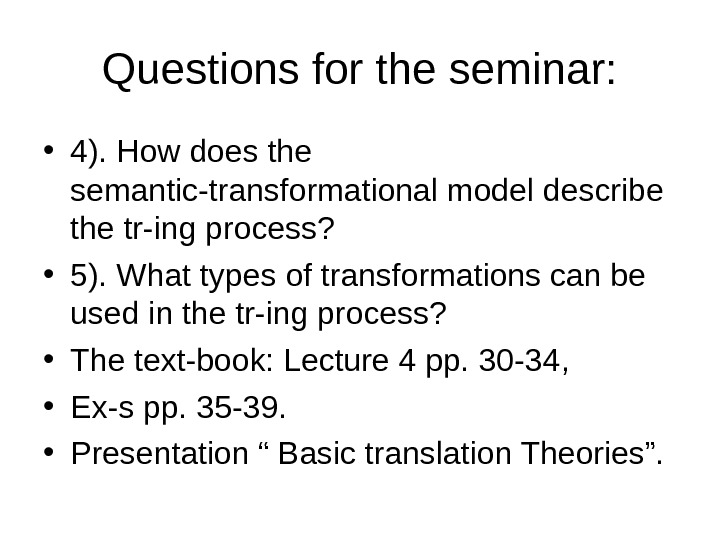Презентация lect.2 Translation Process




































- Размер: 381.5 Кб
- Количество слайдов: 35
Описание презентации Презентация lect.2 Translation Process по слайдам
 Translating Process Lecture 2.
Translating Process Lecture 2.
 Translation- is a ______ of meaning across cultures. More specifically, translation is the ______ and the _____ of creating in a target language (TL) a text which has ________ communicative value as the corresponding text in the _____ language (SL).
Translation- is a ______ of meaning across cultures. More specifically, translation is the ______ and the _____ of creating in a target language (TL) a text which has ________ communicative value as the corresponding text in the _____ language (SL).
 The aim of translation: to ____ the text or message in the TL which is ______ to the original text or message in the SL both ______ and_______. In translation we deal with _____ languages (____ codes) and to verify the information they give us about the ______ objects we should consider ______ situation, and ________ information.
The aim of translation: to ____ the text or message in the TL which is ______ to the original text or message in the SL both ______ and_______. In translation we deal with _____ languages (____ codes) and to verify the information they give us about the ______ objects we should consider ______ situation, and ________ information.
 Translation components Translation is an _______ consisting of the ______ components: 1) elements and structures of the___; 2) elements and structures of the___; 3) ________ rules to transform the elements and structures of the ST into the TT;
Translation components Translation is an _______ consisting of the ______ components: 1) elements and structures of the___; 2) elements and structures of the___; 3) ________ rules to transform the elements and structures of the ST into the TT;
 Translation components 4) _____ of the languages involved in translation; 5) __________and organization of the ST; 6) conceptual content and __________of the TT; 7) ________ of the conceptual contents of the ST and TT.
Translation components 4) _____ of the languages involved in translation; 5) __________and organization of the ST; 6) conceptual content and __________of the TT; 7) ________ of the conceptual contents of the ST and TT.
 Participants There at least ___ participants involved in translation process: the ____ (source), the translator who acts in ______ as the _____ of the SL message and as the ____of the equivalent TL message, the _____ of the TL message of the translated version.
Participants There at least ___ participants involved in translation process: the ____ (source), the translator who acts in ______ as the _____ of the SL message and as the ____of the equivalent TL message, the _____ of the TL message of the translated version.
 Participants The participants of translation The sender The translator who acts in dual capacity as the receptor of the SL message and as the sender of the equivalent TL message The receptor of the TL message of the translated version
Participants The participants of translation The sender The translator who acts in dual capacity as the receptor of the SL message and as the sender of the equivalent TL message The receptor of the TL message of the translated version
 Phases of Translation • Translation as an _______ communicative act includes ____ phases: Communi cation between the Source and Translator Communic ation between the Translator and Receptor of the newly-prod uced text.
Phases of Translation • Translation as an _______ communicative act includes ____ phases: Communi cation between the Source and Translator Communic ation between the Translator and Receptor of the newly-prod uced text.
 • NB! The translator _____ the original message, ______ information contained in it, information as an ______ category, i. e. the plain of contents. • In producing the TL text the translator _____ its plain of expression (= linguistic form) while its plane of contents should remain_____.
• NB! The translator _____ the original message, ______ information contained in it, information as an ______ category, i. e. the plain of contents. • In producing the TL text the translator _____ its plain of expression (= linguistic form) while its plane of contents should remain_____.
 • The message produced by a translator should evoke the ________in the TL receptor as the original message does. • The translator’s duty is to ______to the TL receptor the maximal _____of the info carried by the linguistic signs including the ______ and ______ meanings (info about the _______ reality) and very emotive by the ______ connotation.
• The message produced by a translator should evoke the ________in the TL receptor as the original message does. • The translator’s duty is to ______to the TL receptor the maximal _____of the info carried by the linguistic signs including the ______ and ______ meanings (info about the _______ reality) and very emotive by the ______ connotation.
 • Hence, the linguists distinguish between what they call _______ based on the meanings expressed by linguistic signs and interpretation, involving extra linguistic information. • In fact, these two categories _______ very closely.
• Hence, the linguists distinguish between what they call _______ based on the meanings expressed by linguistic signs and interpretation, involving extra linguistic information. • In fact, these two categories _______ very closely.
 • Translation is often ______ without adequate ______ of the speech act and the _____ described in the text. • A successful translation ______ sufficient knowledge of the subject of translation. • E. g. Indian summer of Forsythe – Последняя любовь Форсайта.
• Translation is often ______ without adequate ______ of the speech act and the _____ described in the text. • A successful translation ______ sufficient knowledge of the subject of translation. • E. g. Indian summer of Forsythe – Последняя любовь Форсайта.
 Operations in the process of translation 1) the translator _____ the TL elements and rules of equivalent selection and ______ on the basis of observed ST elements; 2) he/she_______ consisting of the TL elements selected for substitution; 3) _____ the model of the TT ____ context, situation and _______ info; 4) ____ the TT on the basis of the verified model.
Operations in the process of translation 1) the translator _____ the TL elements and rules of equivalent selection and ______ on the basis of observed ST elements; 2) he/she_______ consisting of the TL elements selected for substitution; 3) _____ the model of the TT ____ context, situation and _______ info; 4) ____ the TT on the basis of the verified model.
 The process of translation Three stages: a) ______ of the ST, situation and background info; b) _____ of the translation model; c) and _____ of the model against the ST and target context (semantic, grammatical, stylistic), situation, and background info ________ the generation of the final TT.
The process of translation Three stages: a) ______ of the ST, situation and background info; b) _____ of the translation model; c) and _____ of the model against the ST and target context (semantic, grammatical, stylistic), situation, and background info ________ the generation of the final TT.
 Aspects of translating process (TP) ________ viewed, the TP includes 2 _____ processes – understanding and verbalization. 1 -st, the translator ______ the contents of ST, i. e. ______ the info it contains to his own _____ program, and then he develops this program into TT. The problem – mental processes are not directly_______.
Aspects of translating process (TP) ________ viewed, the TP includes 2 _____ processes – understanding and verbalization. 1 -st, the translator ______ the contents of ST, i. e. ______ the info it contains to his own _____ program, and then he develops this program into TT. The problem – mental processes are not directly_______.
 Aspects of translating process (TP) Translation models. A model is a ______ representation of the translating process describing mental operations by which the ST or some part of it may be______, irrespective of whether these operations are actually ______ by the translator.
Aspects of translating process (TP) Translation models. A model is a ______ representation of the translating process describing mental operations by which the ST or some part of it may be______, irrespective of whether these operations are actually ______ by the translator.
 Aspects of translating process (TP) There are such models of translating process: 1) the ______model and 2) the ____-transformational model. The existing models of the translating process are based on: 1) on the ______ of the situations described in the original text and in the translation;
Aspects of translating process (TP) There are such models of translating process: 1) the ______model and 2) the ____-transformational model. The existing models of the translating process are based on: 1) on the ______ of the situations described in the original text and in the translation;
 Aspects of translating process (TP) 2) is based on the _____ of basic notions and _____ structures in different languages. In other words, the translator actually makes a ____________ from the original to some ______ level of equivalence and then further on to the text of translation.
Aspects of translating process (TP) 2) is based on the _____ of basic notions and _____ structures in different languages. In other words, the translator actually makes a ____________ from the original to some ______ level of equivalence and then further on to the text of translation.
 Aspects of translating process (TP) Situational model The process goes from the text in one language _____ the extralinguistic situation to the ____in another language. The translator first ______ what the original is about and then says “the _____ things” in TL.
Aspects of translating process (TP) Situational model The process goes from the text in one language _____ the extralinguistic situation to the ____in another language. The translator first ______ what the original is about and then says “the _____ things” in TL.
 Aspects of translating process (TP) “ Manson walked quickly down the platform, searching eagerly for some signs of welcome. ” The main character came by train to a new place of work. The man was alone in a strange place and couldn’t expect any welcome committee. Obviously, he just wanted to see whether anyone was there to meet him.
Aspects of translating process (TP) “ Manson walked quickly down the platform, searching eagerly for some signs of welcome. ” The main character came by train to a new place of work. The man was alone in a strange place and couldn’t expect any welcome committee. Obviously, he just wanted to see whether anyone was there to meet him.
 Aspects of translating process (TP) «Мэнсон быстро прошел по перрону, оглядываясь, не встречает ли его кто-нибудь» .
Aspects of translating process (TP) «Мэнсон быстро прошел по перрону, оглядываясь, не встречает ли его кто-нибудь» .
 Aspects of translating process (TP) Semantic-transformational model This model postulates the existence of the “______” semantic categories common to SL and TL. The translator first _____ the semantic units of the _____ to these basic _____ categories and then expresses the _______ notions by the semantic units of TL.
Aspects of translating process (TP) Semantic-transformational model This model postulates the existence of the “______” semantic categories common to SL and TL. The translator first _____ the semantic units of the _____ to these basic _____ categories and then expresses the _______ notions by the semantic units of TL.
 Aspects of translating process (TP) “ John is the proud owner of the new car”. 1 -st the translator is first _____ that it actually means that “John has a new car”. And that “he is proud because of that”.
Aspects of translating process (TP) “ John is the proud owner of the new car”. 1 -st the translator is first _____ that it actually means that “John has a new car”. And that “he is proud because of that”.
 Aspects of translating process (TP) «У Джона (есть) новая машина, которой он очень гордится» . The translator should use these models as _____ tools. Coming across a specific problem in SL the translator should _____ it as_____, _____ or ______ and try to solve it by resorting to the appropriate procedure.
Aspects of translating process (TP) «У Джона (есть) новая машина, которой он очень гордится» . The translator should use these models as _____ tools. Coming across a specific problem in SL the translator should _____ it as_____, _____ or ______ and try to solve it by resorting to the appropriate procedure.
 Aspects of translating process (TP) “ He is a poor sleeper”. An attributive group can’t be directly transferred into Russian. The translator can find that the _______ will do the trick for him here. So he should transform the attributive group into a verb-adverb phrase : «Он плохо спит» .
Aspects of translating process (TP) “ He is a poor sleeper”. An attributive group can’t be directly transferred into Russian. The translator can find that the _______ will do the trick for him here. So he should transform the attributive group into a verb-adverb phrase : «Он плохо спит» .
 Different types of operations performed by the translator: 1) the first group of operations (transformations) is characterized by _____ of the form of a word (translational_______) or of a collocation (creates a ________in TL by using a loan translation). «Эскалация, консенсус» «Мозговой трест» ( brain trust ), «работа по правилам» ( work-to-rule ), «люди доброй воли» ( people of good will ).
Different types of operations performed by the translator: 1) the first group of operations (transformations) is characterized by _____ of the form of a word (translational_______) or of a collocation (creates a ________in TL by using a loan translation). «Эскалация, консенсус» «Мозговой трест» ( brain trust ), «работа по правилам» ( work-to-rule ), «люди доброй воли» ( people of good will ).
 Types of operations performed by the translator 2). The second group of operations includes all types of ______ transformations invoking certain ______ changes. As a result, the _____of a word or word combination in ST may be more____, more general or somewhat ____ as a way to discovering an ______ equivalent in TL.
Types of operations performed by the translator 2). The second group of operations includes all types of ______ transformations invoking certain ______ changes. As a result, the _____of a word or word combination in ST may be more____, more general or somewhat ____ as a way to discovering an ______ equivalent in TL.
 Types of operations performed by the translator The equivalent with a more general meaning: I packed my two Gladstones. «Я упаковал свои два чемодана» .
Types of operations performed by the translator The equivalent with a more general meaning: I packed my two Gladstones. «Я упаковал свои два чемодана» .
 Types of operations performed by the translator 3). The third group of translating procedures comprises ______of transformations involving units of SL______. The translator may solve his problems by ______ the syntactic structure of the ST and using the analogous TL ______ or a “word-for-word translation”.
Types of operations performed by the translator 3). The third group of translating procedures comprises ______of transformations involving units of SL______. The translator may solve his problems by ______ the syntactic structure of the ST and using the analogous TL ______ or a “word-for-word translation”.
 Types of operations performed by the translator John took Mary by the hand. — Джон взял Мери за руку. I want you to speak English. — Я хочу, чтобы вы говорили по-английски. This was a man to be seen to be understood. — Чтобы понять этого человека, надо было его увидеть.
Types of operations performed by the translator John took Mary by the hand. — Джон взял Мери за руку. I want you to speak English. — Я хочу, чтобы вы говорили по-английски. This was a man to be seen to be understood. — Чтобы понять этого человека, надо было его увидеть.
 Norm of translation There are _____ normative requirements which compose the norm of translation: • norms of translation_______, genre and _____ norms of translation, norms of translation______, ______norms of translation, _______norms of translation.
Norm of translation There are _____ normative requirements which compose the norm of translation: • norms of translation_______, genre and _____ norms of translation, norms of translation______, ______norms of translation, _______norms of translation.
 Translation difficulties There are ____ types of translation difficulties: peculiarities of language units____, discrepancies of_____, discrepancies of_____.
Translation difficulties There are ____ types of translation difficulties: peculiarities of language units____, discrepancies of_____, discrepancies of_____.
 Methods of research in translation There are 4 types of comparative analysis used in the modern theory of translation: comparing the translation text with its_____, comparing _____translations of one and the same text prepared by _____translators, comparing translations with original texts in the _______ of translation, comparative _____texts in the source and target languages.
Methods of research in translation There are 4 types of comparative analysis used in the modern theory of translation: comparing the translation text with its_____, comparing _____translations of one and the same text prepared by _____translators, comparing translations with original texts in the _______ of translation, comparative _____texts in the source and target languages.
 Questions for the seminar: • Topics for discussion: 1). What is the tr-ing process? What mental processes make up the tr-ing process? • 2). What is the model of tr-n? How can tr-n models be classified? • 3). How does the situational model describe the tr-ing process?
Questions for the seminar: • Topics for discussion: 1). What is the tr-ing process? What mental processes make up the tr-ing process? • 2). What is the model of tr-n? How can tr-n models be classified? • 3). How does the situational model describe the tr-ing process?
 Questions for the seminar: • 4). How does the semantic-transformational model describe the tr-ing process? • 5). What types of transformations can be used in the tr-ing process? • The text-book: Lecture 4 pp. 30 -34, • Ex-s pp. 35 -39. • Presentation “ Basic translation Theories”.
Questions for the seminar: • 4). How does the semantic-transformational model describe the tr-ing process? • 5). What types of transformations can be used in the tr-ing process? • The text-book: Lecture 4 pp. 30 -34, • Ex-s pp. 35 -39. • Presentation “ Basic translation Theories”.

